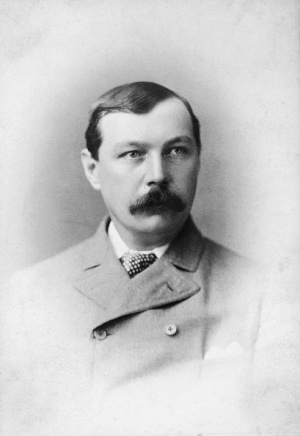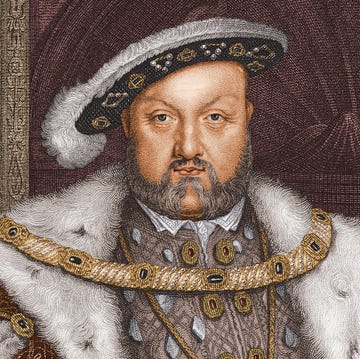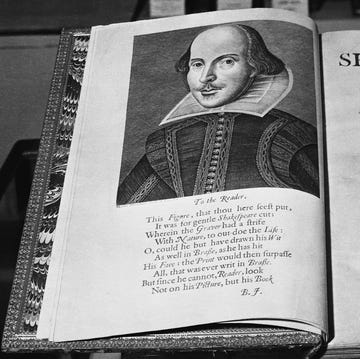Not logged in
Page actions.
- View source

Sir Arthur Ignatius Conan Doyle , M.D., Kt, D.L., LL.D. , (22 may 1859 - 7 july 1930) was a British writer with many facets : Physician, Writer, Sportsman, Poet, Politician, Justicer, Spiritualist, Campaigner, Adventurer...
The following is a short overview. Arthur Conan Doyle wrote his own biography Memories and Adventures in 1923-1924.
See also A Life in Pictures and A Life in Movies .
- 1.1 Childhood
- 1.2 Schools
- 1.3 University
- 1.4 Medical practice
- 1.5 First marriage
- 1.6 Celebrity
- 1.7 The Boer War
- 1.8 Second marriage
- 1.9 World War I
- 1.10 Spiritualism
- 2 The Old Horse
- 3 Published Biographies
Birth, Family.
Arthur Conan Doyle was born on 22 may 1859, at Picardy Place, Edinburgh, Scotland. His mother, Mary Josephine Foley , was Irish and descendant of the famous Percy family of Northumberland, in the line of Plantagenet. His father, Charles Altamont Doyle , was a not very ambitious officer with some artistic talent [1] . When he lost his job, he sank into alcoholism and was interned after severe seizures before dying in 1893. The three brothers of his father distinguished themselves in England: James wrote The Chronicles of England , Henry was director of the National Gallery in Dublin and Richard was one of the most famous illustrators of Punch . Arthur was the second of seven children ( Annette , Caroline , Constance , Innes , Jane and Bryan Mary ).
Hodder, Stonyhurst, Feldkirch.
His education began at home and in a small Edinburgh school. At nine, he entered the Jesuit college Hodder in Lancashire to prepare his admission to the Stonyhurst College. He succeeded two years later and was already interested about literature like Walter Scott, Jules Verne or Macaulay. He even founded a little magazine, The Stonyhurst Figaro . However, the Jesuit education hardly suited him and when he left the school in 1875, he completely rejected Christianity, and preferred to be agnostic. Nevertheless, he spent an additional year at a Jesuit college in Feldkirch, Austria, to improve his German.
University, Joseph Bell, Professor Rutherford, First short stories.
In 1876, he began his medical studies at the University of Edinburgh. There he met two men who influenced the choice of his future novel heroes. Professor Rutherford, whose Assyrian beard, booming voice and broad chest, inspired him Professor George Edward Challenger [2] and Dr. Joseph Bell , Professor of Surgery, whose amazing deductions on his patients and their diseases did germinate the idea of a detective using the same methods. In 1879, two of his short stories were published anonymously ( The Mystery of Sasassa Valley and The American's Tale ).

Medical practice
Hope, Mayumba, Medical practice, Dr. George Turnavine Budd, Ophtalmology.
Alongside his studies, Arthur tried to earn some money to help his family. In 1880, he worked as a medical assistant in Sheffield, Birmingham and Shropshire and doctor aboard a whaler, the Hope , in Greenland.
On 22 october 1881, he graduated and enlisted as a doctor aboard a steamer (the SS Mayumba) to Western Africa. The voyage was unpleasant because of a storm and a fire on board, and Conan Doyle became seriously ill (probably malaria) in Lagos. He then decided to use his skills more peacefully. After a brief and disastrous partnership in 1882, with a colleague, Dr. George Turnavine Budd , he opened a practice of ophthalmology in Southsea, near Portsmouth. His clientele left him plenty of time to read, write and began to publish other short stories but without great success.
First marriage
Louisa Hawkins, Mary Louise Conan Doyle, Kingsley Conan Doyle, The Firm of Girdlestone, A Study in Scarlet, Micah Clarke, Vienna.
In august 1885, he married Louisa Hawkins ("Touie"), the sister of one of his rare patients. She gave him two children ( Mary Louise and Kingsley ) and encouraged him to persevere in literature. He followed her advice because in 1886 he finished his first novel, The Firm of Girdlestone , but failed to find a publisher (it will be serialized in 1889-1890 in The People newspaper).
In 1887, he wrote his first Sherlock Holmes adventure, A Study in Scarlet . The manuscript was rejected by several publishers before Ward, Lock & Co. bought it for the paltry sum of £25. They published it in their Beeton's Christmas Annual in november 1887 and was totally unnoticed at the time. But the young author, disciple of Walter Scott, was already working on historical novels (the kind he considered the only worthy of his vocation) like Micah Clarke (published in 1889). Having some success, he devoured the chroniclers of the Middle Ages as Froissart and Philippe Commynes. As a result, he wrote The White Company (published in 1891). With this novel, which is a somewhat an idealized description of the English chivalry, Conan Doyle was proud to give England a second Ivanhoe .
In august 1889, during a dinner hosted by J. M. Stoddart , an American agent of the Lippincott's Magazine , Conan Doyle and Oscar Wilde were hired to write two stories. Published in 1890, Wilde wrote The Picture of Dorian Gray and Conan Doyle The Sign of Four , the second adventure of the detective. The same year, the Conan Doyles stayed a few months in Vienna for Arthur to improve his medical knowledge. Back in England, they moved to London on Montague Place and the young doctor's office opens at 2 Devonshire Place. Patients were scarce again, Conan Doyle took up the pen again.
Sherlock Holmes, Lecture tour in USA, Davos, A Story of Waterloo, Egypt.
In january 1891, discovering the first issue of The Strand Magazine , he decided to write to the publisher and proposed new adventures of the detective as short stories, including A Scandal in Bohemia and The Red-Headed League . He then provided five other short stories and renewed his contract for six additional stories at the rate of one per month [3] . The success was stunning. He abandoned medicine and devoted himself entirely to writing. Nevertheless, he wanted his name to remain associated with more literary works and in november 1891 he wrote to his mother: "I plan to kill Holmes in the sixth adventure. He prevents me from thinking to better things." His mother then started to find him more plots [4] and Sherlock Holmes got a reprieve.
Conan Doyle moved in december 1892 to Davos, Switzerland, where the air was healthier for his wife suffering from tuberculosis. Not far away are the Reichenbach Falls , a gorgeous, magnificent and terrifying framework for a dramatic end. After a series of twelve new adventures [5] , Holmes died there, resulted in a fall into the abyss with Professor Moriarty ( The Adventure of the Final Problem ). Despite fierce public outcry, and under his mother's pressure, Conan Doyle refused to resurrect his detective.
A new life began. In 1894, he gave a series of lectures in the United States and was received by Rudyard Kipling in Vermont. He also corresponded with Robert Louis Stevenson which told him he was telling the Sherlock Holmes stories to the Samoan natives. The same year, his play A Story of Waterloo was performed in London with Henry Irving at the Lyceum Theatre.
In Davos, he gives a demonstration of ski which he has discovered in Norway during a previous trip [6] . This is the first time that such "snow shoes" were introduced in the Alps. There, he also wrote The Exploits of Brigadier Gerard (first novel in the saga of the soldier of the First Empire) and Rodney Stone (a novel about boxing). During the fall of 1895, in order to improve the health of his wife, Conan Doyle stayed in Egypt for several months. When the conflict between the British and the dervishes was growing seriously, he became a war correspondent for the Westminster Gazette . These events inspired him the novel The Tragedy of the Korosko .
The Boer War
The Great Boer War, Political adventures, The War in South Africa: Its Cause and Conduct, Knighthood, The Edalji Case.
In october 1899, war broke out between England and African Orange and Transvaal Republics in South Africa. Conan Doyle engaged in december. Unfortunately, the Middlesex Yeomanry Regiment put him on a waiting list. Meanwhile, a friend, John Langman, who wished to raise a fifty-beds hospital in South Africa, offered him to supervise the operation. From march to august 1900, he led the hospital in Bloemfontein, capital of the Orange state. In october 1900, he ran for election in Edinburgh for MP, in favor of retaining Ireland within the United Kingdom. But was defeated.
After his return to England, he wrote two books related to the war, The Great Boer War (1901) and The War in South Africa: Its Cause and Conduct (1902). The latter was virulent against those who accused the English of abusing the Boers (rapes, use of dum-dum bullets...). This position, rather than his participation in the conflict earned him the title of Knight Bachelor . He was from then: Sir Arthur Conan Doyle .
Sherlock Holmes then made a temporary return. The Hound of the Baskervilles was serialized between august 1901 and may 1902 in The Strand Magazine . But it is an adventure which takes place shortly before the death of the detective. It was only in 1903 that an American publisher convinced Conan Doyle to resurrect the detective, by offering him a large amount of money. Then, thirty-three new stories will be published between september 1903 ( The Adventure of the Empty House ) and march 1927 ( The Adventure of Shoscombe Old Place ) [7] .
In january 1906, Sir Arthur ran for elections (always Unionist so conservative) and suffered another defeat. The health of his wife Louisa suddenly worsen. Tumor occured and caused partial paralysis. She gradually weakened and died on 4 july 1906. This drama plunged him into a state of prostration near depression.
He then launched headlong into the George Edalji case, a young notary of Indian origin, sentenced to seven years of prison for mutilating cattle and sending anonymous letters. In the manner of Sherlock Holmes, Conan Doyle lead his own investigation and proved his innocence.
Second marriage
Jean Leckie, Denis, Adrian and (Lena) Jean, The Crime of the Congo, Oscar Slater, The Prince Henry Tour, The Lost World.
In september 1907, Conan Doyle married Jean Elizabeth Leckie with whom he was in love since 1897 but always maintained a friendly relationship in respect for his wife. He moved to Crowborough in Sussex, where Jean gave him three children ( Denis , Adrian and Jean ).
Two years later, the public discovered the crimes committed in Congo by the Belgian administration. Conan Doyle decided to take action at an international level by publishing The Crime of the Congo , sending several articles in newspapers and corresponding with the President of the United States and the Emperor of Germany. All means were good to stop these crimes, which in twenty years, did more than a century of slavery victims across Africa.
Conan Doyle intervened in 1910 to restore the truth in the Oscar Slater case, a German Jew accused of murder and sentenced to death. He noted serious irregularities in the police investigation. Convinced of the innocence of the man, he sought to prove it. He didn't success completely but managed to commute the death sentence to life imprisonment [8] .
In 1911, Conan Doyle drove his green 16 horse-power Dietrich-Lorraine from Germany to England for 15 days during The Prince Henry Tour .
In 1912, Conan Doyle created a new character that will mark the literary world: the Professor Challenger in the novel: The Lost World .
World War I
To Arms!, Volunteers, Sir Roger Casement, Spiritualism.
When World War I broke out in 1914, Conan Doyle formed a local volunteer unit that would later become officially The Crowborough Company of the 6th Royal Sussex Volunteer Regiment , where he served as second class. But when he wanted to go to the front, this "privilege" was refused due to his advanced age (55 years-old). So he put his pen to the service of his country and published a pamphlet entitled To Arms! . Throughout the war, he wrote carefully the history of the Great War day by day [9] . For this, he was directly communicating with generals on the battlefield. In 1916, he visited the English, Italian and French fronts and even met Clemenceau. The same year, his eldest son, Kingsley , was seriously wounded at the Battle of the Somme. He died of pneumonia in october 1918. The following february, his brother, Innes (Brigadier General) died the same way.
Also in 1916, Conan Doyle intervened to obtain the grace of Sir Roger Casement, a leader of the Irish insurgents who joined the Germans. Despite all his efforts the writer could not save him. Accused of treason, Sir Roger Casement was executed.
Spiritualism
In october 1916, Conan Doyle announced in the journal Light his conversion to spiritualism. During the last years of his life, he became the "crusader" of this movement that preaches salvation of humanity through science.
Thus, from 1920 to 1923, he gave a series of lectures about spiritualism in Australia, in USA and in Canada. He published his autobiography, Memories and Adventures in 1924 and opened a bookstore dedicated to spiritualism, The Psychic Bookshop in London, where he handled the editing of his own works. In particular he published The History of Spiritualism in two volumes and The Land of Mist , the latest adventure of Professor Challenger on a spiritualism topic.
He spent more time on lectures: in 1925 in Paris, at the International Spiritualist Congress ; in 1928 in London, at the Congress he chaired himself, and then in South Africa, Rhodesia, Kenya, Holland, and the Scandinavian countries. After these trips, in 1929, exhausted, he suffered a heart attack.
Nevertheless, against the advice of his doctors, he insisted on speaking at a ceremony commemorating the Armistice, then spent weeks in bed. He recovered slowly but on 7 july 1930 at dawn, he died from a final heart attack. His last words to his wife at his side were "You are wonderful".
The Old Horse

Published Biographies
- Biographies
- Books with biographical content
- ↑ Probably inherited from his father John Doyle , the famous cartoonist "HB". Charles Altamont Doyle was one of the first to illustrate the investigations of Sherlock Holmes . There are six of his drawings in A Study in Scarlet published in 1888 ( Ward, Lock & Co. ) where Holmes is shown bearded.
- ↑ The Lost World , The Poison Belt and The Land of Mist .
- ↑ The twelve new stories will be collected later in The Adventures of Sherlock Holmes .
- ↑ She proposed, for example, the plot of The Adventure of the Copper Beeches .
- ↑ From december 1892 to december 1893. The stories will be collected later in The Memoirs of Sherlock Holmes .
- ↑ In 1892, the Conan Doyles spent their holidays there with Jerome K. Jerome , the author of Three Men on a boat .
- ↑ Stories collected in The Memoirs of Sherlock Holmes , His Last Bow and The Case-Book of Sherlock Holmes . Plus the novel: The Valley of Fear .
- ↑ The innocence of Slater will be recognized in 1928.
- ↑ The British Campaign in France and Flanders (in 6 volumes). He completed it only in 1920.
- Back to Sir Arthur Conan Doyle
- Sir Arthur Conan Doyle
- A Life in Pictures
- A Life in Movies
- Sherlock Holmes
- Professor Challenger
- Brigadier Gerard
- Captain Sharkey
- Sir Nigel Loring
- All fictions
- Search Fictions
- Essays, Articles
- His Handwriting
- Manuscripts
- Drawings & Paintings
- Illustrators
- Periodicals
Adaptations
Contact/support.
- Special pages
- Cite this page

User page tools
- What links here
- Related changes
- Printable version
- Permanent link
- Page information
- This page was last modified on 28 August 2024, at 10:15.
- Privacy policy
- About The Arthur Conan Doyle Encyclopedia
- Disclaimers
Arthur Conan Doyle

(1859-1930)
Who Was Arthur Conan Doyle?
In 1890, Arthur Conan Doyle's novel, A Study in Scarlet introduced the character of Detective Sherlock Holmes. Doyle would go on to write 60 stories about Sherlock Holmes. He also strove to spread his Spiritualism faith through a series of books that were written from 1918 to 1926. Doyle died of a heart attack in Crowborough, England on July 7, 1930.
On May 22, 1859, Arthur Conan Doyle was born to an affluent, strict Irish-Catholic family in Edinburgh, Scotland. Although Doyle's family was well-respected in the art world, his father, Charles, who was a life-long alcoholic, had few accomplishments to speak of. Doyle's mother, Mary, was a lively and well-educated woman who loved to read. She particularly delighted in telling her young son outlandish stories. Her great enthusiasm and animation while spinning wild tales sparked the child's imagination. As Doyle would later recall in his biography, "In my early childhood, as far as I can remember anything at all, the vivid stories she would tell me stand out so clearly that they obscure the real facts of my life."
At the age of 9, Doyle bid a tearful goodbye to his parents and was shipped off to England, where he would attend Hodder Place, Stonyhurst — a Jesuit preparatory school — from 1868 to 1870. Doyle then went on to study at Stonyhurst College for the next five years. For Doyle, the boarding-school experience was brutal: many of his classmates bullied him, and the school practiced ruthless corporal punishment against its students. Over time, Doyle found solace in his flair for storytelling and developed an eager audience of younger students.
Medical Education and Career
When Doyle graduated from Stonyhurst College in 1876, his parents expected that he would follow in his family's footsteps and study art, so they were surprised when he decided to pursue a medical degree at the University of Edinburgh instead. At med school, Doyle met his mentor, Professor Dr. Joseph Bell, whose keen powers of observation would later inspire Doyle to create his famed fictional detective character, Sherlock Holmes. At the University of Edinburgh, Doyle also had the good fortune to meet classmates and future fellow authors James Barrie and Robert Louis Stevenson. While a medical student, Doyle took his own first stab at writing, with a short story called The Mystery of Sasassa Valley . That was followed by a second story, The American Tale , which was published in London Society .
During Doyle's third year of medical school, he took a ship surgeon's post on a whaling ship sailing for the Arctic Circle. The voyage awakened Doyle's sense of adventure, a feeling that he incorporated into a story, Captain of the Pole Star .
In 1880, Doyle returned to medical school. Back at the University of Edinburgh, Doyle became increasingly invested in Spiritualism or "Psychic religion," a belief system that he would later attempt to spread through a series of his written works. By the time he received his Bachelor of Medicine degree in 1881, Doyle had denounced his Roman Catholic faith.
Doyle's first paying job as a doctor took the form of a medical officer's position aboard the steamship Mayumba, traveling from Liverpool to Africa. After his stint on the Mayumba, Doyle settled in Plymouth, England for a time. When his funds were nearly tapped out, he relocated to Portsmouth and opened his first practice. He spent the next few years struggling to balance his burgeoning medical career with his efforts to gain recognition as an author. Doyle would later give up medicine altogether, in order to devote all of his attention to his writing and his faith.
Personal Life
In 1885, while still struggling to make it as a writer, Doyle met and married his first wife, Louisa Hawkins. The couple moved to Upper Wimpole Street and had two children, a daughter and a son. In 1893, Louisa was diagnosed with tuberculosis. While Louisa was ailing, Doyle developed an affection for a young woman named Jean Leckie. Louisa ultimately died of tuberculosis in Doyle's arms, in 1906. The following year, Doyle would remarry to Jean Leckie, with whom he would have two sons and a daughter.
Books: Sherlock Holmes
In 1886, newly married and still struggling to make it as an author, Doyle started writing the mystery novel A Tangled Skein . Two years later, the novel was renamed A Study in Scarlet and published in Beeton's Christmas Annual . A Study in Scarlet , which first introduced the wildly popular characters Detective Sherlock Holmes and his assistant, Watson, finally earned Doyle the recognition he had so desired. It was the first of 60 stories that Doyle would pen about Sherlock Holmes over the course of his writing career. Also, in 1887, Doyle submitted two letters about his conversion to Spiritualism to a weekly periodical called Light .
Doyle continued to actively participate in the Spiritualist movement from 1887 to 1916, during which time he wrote three books that experts consider largely autobiographical. These include Beyond the City (1893), The Stark Munro Letters (1895) and A Duet with an Occasional Chorus (1899). Upon achieving success as a writer, Doyle decided to retire from medicine. Throughout this period, he additionally produced a handful of historical novels including one about the Napoleonic Era called The Great Shadow in 1892, and his most famous historical novel, Rodney Stone , in 1896.
The prolific author also composed four of his most popular Sherlock Holmes books during the 1890s and early 1900s: The Sign of Four (1890), The Adventures of Sherlock Holmes (1892), The Memoirs of Sherlock Holmes (1894) and The Hound of Baskervilles , published in 1901. In 1893, to Doyle's readers' disdain, he had attempted to kill off his Sherlock Holmes character in order to focus more on writing about Spiritualism. In 1901, however, Doyle reintroduced Sherlock Holmes in The Hound of Baskervilles and later brought him back to life in The Adventure of the Empty House so the lucrative character could earn Doyle the money to fund his missionary work. Doyle also strove to spread his faith through a series of written works, consisting of The New Revolution (1918), The Vital Message (1919), The Wanderings of a Spiritualist (1921) and History of Spiritualism (1926).
In 1928, Doyle's final twelve stories about Sherlock Holmes were published in a compilation entitled The Casebook of Sherlock Holmes .
Having recently been diagnosed with Angina Pectoris, Doyle stubbornly ignored his doctor's warnings, and in the fall of 1929, embarked on a spiritualism tour through the Netherlands. He returned home with chest pains so severe that he needed to be carried on shore and was thereafter almost entirely bedridden at his home in Crowborough, England. Rising one last time on July 7, 1930, Doyle collapsed and died in his garden while clutching his heart with one hand and holding a flower in the other.
QUICK FACTS
- Name: Arthur Conan Doyle
- Birth Year: 1859
- Birth date: May 22, 1859
- Birth City: Edinburgh
- Birth Country: Scotland
- Gender: Male
- Best Known For: Author Arthur Conan Doyle wrote 60 mystery stories featuring the wildly popular detective character Sherlock Holmes and his loyal assistant Watson.
- Journalism and Nonfiction
- Fiction and Poetry
- Astrological Sign: Gemini
- Hodder Place, Stonyhurst
- Stonyhurst College
- University of Edinburgh
- Nacionalities
- Scot (Scotland)
- Death Year: 1930
- Death date: July 7, 1930
- Death City: Crowborough
- Death Country: United Kingdom
We strive for accuracy and fairness.If you see something that doesn't look right, contact us !
CITATION INFORMATION
- Article Title: Arthur Conan Doyle Biography
- Author: Biography.com Editors
- Website Name: The Biography.com website
- Url: https://www.biography.com/authors-writers/arthur-conan-doyle
- Access Date:
- Publisher: A&E; Television Networks
- Last Updated: June 17, 2020
- Original Published Date: April 3, 2014
- Where there is no imagination there is no horror.

Famous British People

Ralph Fiennes

Liam Payne’s Girlfriend Speaks Out After His Death

Daniel Day-Lewis

Maggie Smith

Alan Cumming

Olivia Colman

Richard III

20 Shakespeare Quotes

William Shakespeare

Andy Murray

IMAGES
VIDEO
COMMENTS
Sir Arthur Ignatius Conan Doyle KStJ, DL (22 May 1859 – 7 July 1930) was a British writer and physician. He created the character Sherlock Holmes in 1887 for A Study in Scarlet, the first of four novels and fifty-six short stories about Holmes and Dr. Watson. The Sherlock Holmes stories are milestones in the field of crime fiction. Doyle was a prolific writer. In addi…
Arthur Conan Doyle (born May 22, 1859, Edinburgh, Scotland—died July 7, 1930, Crowborough, Sussex, England) was a Scottish writer best known for his creation of the …
Sir Arthur Conan Doyle KStJ, DL (1859–1930) was a Scottish …
Создатель классических персонажей детективной, научно-фантастической и историко-приключенческой литературы: гениального сыщика Шерлока Холмса, эксцентричного профессора Челленджера, бравого …
Sir Arthur Conan Doyle (22 May 1859 – 7 July 1930) was a British doctor and author. [1][2] He is well known because he wrote short stories about the detective Sherlock Holmes. He also wrote science fiction and historical stories. He …
Sir Arthur Ignatius Conan Doyle, M.D., Kt, D.L., LL.D., (22 may 1859 - 7 july 1930) was a British writer with many facets : Physician, Writer, Sportsman, Poet, Politician, Justicer, Spiritualist, Campaigner, Adventurer...
Author Arthur Conan Doyle wrote 60 mystery stories featuring the wildly popular detective character Sherlock Holmes and his loyal assistant Watson.